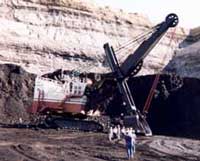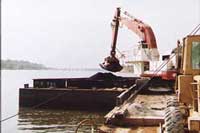Geology and Sources of Energy
by Steve Sharp, P.E.
Some of our mineral resources can be taken out of the ground and used for fuel. Raw materials have two sources: they can be grown or they can be mined. Coal, oil and gas are collectively called fossil fuels, because they formed from organic (living) matter.
Uranium is also a source of energy that is taken out of the ground. These fuels that are mined are called non-renewable resources, because we can't replace them. That's why wise use of our raw materials is important.

The ways that electricity was generated in Arkansas in 1997. This data is from the Energy Information Agency.
There are several naturally occurring sources of energy that are used in Arkansas to generate electricity. Electricity is perhaps the most readily available form of energy that we all use everyday in our homes, schools, offices, businesses and factories. Coal, natural gas, fuel oil, uranium and falling or flowing water are all used to generate large amounts of electricity in Arkansas. Wind and solar energy are also used by some, but the amount of electricity they generate is very small.
Coal, natural gas and the crude oil from which fuel oil can be refined are all present in Arkansas. No minable amount of uranium occurs here.
For electricity generated in Arkansas, coal fuels approximately 55 percent of the total, uranium (nuclear) 31 percent, natural gas 8 percent, fuel oil less than one percent, and water (hydroelectric) 6 percent.
 Even though coal, natural gas and crude oil are found in Arkansas, most of these fuels that are burned in power plants in our state are transported to Arkansas from other states. The reason is that at this time, it is more economical to purchase these energy products from mines or wells that are located where very large reserves of these products occur naturally close to the earth's surface. Most of the coal we burn in Arkansas comes from Wyoming. Most of the natural gas we burn in Arkansas comes from Texas or Oklahoma, and most of the fuel oil we burn is refined from crude oil that comes from Louisiana or Texas.
Even though coal, natural gas and crude oil are found in Arkansas, most of these fuels that are burned in power plants in our state are transported to Arkansas from other states. The reason is that at this time, it is more economical to purchase these energy products from mines or wells that are located where very large reserves of these products occur naturally close to the earth's surface. Most of the coal we burn in Arkansas comes from Wyoming. Most of the natural gas we burn in Arkansas comes from Texas or Oklahoma, and most of the fuel oil we burn is refined from crude oil that comes from Louisiana or Texas.
 Coal is transported to our state by railroad and barge. This photo shows coal being unloaded from a barge on the Arkansas River. Natural gas is delivered by pipeline, and fuel oil is brought to us by barges on the rivers, railroad or by truck.
Coal is transported to our state by railroad and barge. This photo shows coal being unloaded from a barge on the Arkansas River. Natural gas is delivered by pipeline, and fuel oil is brought to us by barges on the rivers, railroad or by truck.
Coal is one of the most valuable resources found in the United States today. Approximately 1 billion tons of coal are mined in America annually. Even so, we have in our country enough coal reserves to last for several hundred years at the present rate of consumption. There are recoverable reserves of coal in at least 35 states which includes Arkansas. Without an adequate supply of coal, America would not enjoy its present high standard of living.
 Natural gas being flared or burned from a new well during a test in Franklin County, Arkansas.
Natural gas being flared or burned from a new well during a test in Franklin County, Arkansas.
Origin of Coal
Coal was formed from the plants that grew on earth millions of years ago. Imprints of these plants are called fossils and often appear on lumps of coal and adjacent rocks.
Thousands of years were required to accumulate the plant material needed to form even a thin layer of coal. Current estimates range from 9,000 to 12,000 years per foot of coal. Less time was required in cases where the plant material drifted into the area.
The deposition of a coal seam began with plant matter being deposited in water so it would not decay like plant matter does on dry land. Eventually, it became peat and with burial and compression (and time) became lignite. With further compression and heat, volatiles (like oils) were forced out, converting it to bituminous and finally to anthracite. Approximately 5 to 10 feet of plant matter was needed for each foot of coal.
This process of coal formation was repeated sporadically over many years, resulting in the formation of multiple coal seams separated by varying thicknesses of sediment and rock. The uppermost layers can often be seen in cuts along highways in hilly regions.
Mining
Coal was first used in this country by the American Indians. While it was used primarily for ornamental purposes, the Hopi Indians, who lived in what is now Arizona, also burned it to fire their pottery.
Coal was discovered along outcrops of the Illinois River by French explorers in 1679. However, it was not mined commercially until about 1745 when it was removed from outcrops near Richmond, Virginia. Subsequently, these surface mines became underground mines after the surface coal was removed. Today, coal is still taken from the ground in both surface and underground operations.
The coal that comes to Arkansas today from Wyoming is mined in large surface mines. After the coal is removed the land is restored. The restored land is actually better for growing vegetation than it was before the coal was removed.
Arkansas Lignite
Investigations in Arkansas during the late 1970s to early 1980s proved important large reserves of lignite were present in several deposits in the southern half of the state. Although not presently mined, it will be available when needed and is compatible for coal-fired generation of electricity and as a resource material for the production of oils for the manufacture of synthetic fuels, plastics, etc.
Arkansas' Hard Coals
The portion of the Arkansas Valley region that extends from Fort Smith to Russellville contains the most extensive deposits of hard coals in the state (bituminous and anthracite). This coal-bearing region is an eastern extension of a large coal basin present in eastern Oklahoma, eastern Kansas, northwestern Missouri, and southern Iowa. Coal has been commercially mined continously in the state from 1870 to today. Although its principal use has been for heating, Arkansas hard coal is considered a metallurgical grade coal, usable for the smelting of iron ores and generation of coke (a material used in steel manufacture).